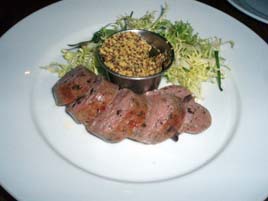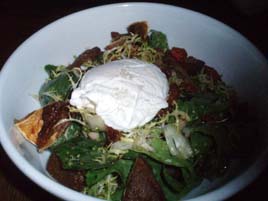
For the second major meal of our London trip, we chose the two-star Le Gavroche. This restaurant opened in 1967 in Sloane Street, moving in 1981 to its current quarters in Upper Brook Street, just steps away from Hyde Park, where it earned its third Michelin star, the first U.K. restaurant to be so honored.
The founding chef, Michel Roux, left to take over The Waterside Inn in Bray, which I reviewed two years ago. His son, Michel Roux Jr., took over as chef de cuisine. Michelin docked a star, leaving Le Gavroche with two. The Waterside Inn is the prettier location, but we found the cuisine here more impressive. This was probably our best meal since the late lamented Alain Ducasse at the Essex House.
 The restaurant is on the lower level of an elegant Georgian townhouse, with a hotel occupying the upper levels. The Roux family once owned the hotel too, but it is now independent. The dining room walls are deep green, the banquettes plush. Ducks and roosters dominate the décor, along with orchids.
The restaurant is on the lower level of an elegant Georgian townhouse, with a hotel occupying the upper levels. The Roux family once owned the hotel too, but it is now independent. The dining room walls are deep green, the banquettes plush. Ducks and roosters dominate the décor, along with orchids.
The restaurant is named for the little urchin in Victor Hugo’s Les Misérables. That little figure appears everywhere at Le Gavroche, including the handles of all the flatware, many of the serving pieces, the door to the kitchen, and probably other places I failed to notice.
Prices can only be described as staggering. The Menu Exceptionnel (a long tasting menu) was £95 (around $190) per person. I didn’t take note of individual prices, except to note that many entrées were upwards of $70 or $80 apiece (and some more than that), with many appetizers in the $40 to $60 range. As we noted the night before, in relation to what we were already bound to spend anyway, the tasting menu seemed to be a bargain. so we chose that once again.
Once again, we avoided ordering until we had settled on a wine. And once again, the staff acted as if this was an unusual procedure, though we didn’t get the snooty reaction we had at Hibiscus. Here the choice was more difficult, as the wine list is a large volume. I noted that the largest section was the French Bordeaux, so I asked the sommelier for a Bordeaux under £60. You can imagine my surprise when he recommended a 1997 St. Julien at just £48. He decanted it with much ceremony, holding a candle up to the bottle to check for sediment. (In the U.S., Bern’s Steakhouse is the only restaurant where I have observed that procedure.)
I apologize in advance for the poor quality of the photos. The ambient lighting here was low, and we didn’t feel it was appropriate to use the flash. It went off once by accident; it will probably be pretty obvious which photo that was.


The canapés (above left) were smoked duck and foie gras. I liked the duck a bit better, but they were both excellent. The bread service offered two contrasting butters (salted, not) and multiple breads, but none of them were memorable. We then moved on to our eight-course menu, a copy of which was on the table, a method I like much better than long explanations delivered at the table.
1) Lobster Salad with Mango, Avocado, Basil and Lime (above right), stuffed in an endive leaf.


2) Langoustine and Snails (above left) in a light Hollandaise sauce, flavored with Basque pepper and parsley. As Michelle noted, though the menu did not, there was about half a pound of butter in this dish. It was intensely creamy, but the combination worked beautifully.
3) Seared Sea Bass (above right) on a soft polenta, roast pepper coulis, olive and garlic croutons. Michelle called it “one of the prettiest fish presentations I’ve seen,” and “just amazing.” The intense olive and pepper taste worked well with the perfectly prepared fish.


4) Hot Foie Gras and Crispy Pancake of Duck (above left) flavored with cinnamon. This was perhaps the best foie gras dish ever: amazing. The seared foie reduced to liquid almost instantly, but it seemed neither fatty nor heavy. It was a fairly large serving, too. The duck pancake was the pancake I want for breakfast every day.
5) Roasted Rack of Welsh Lamb (above right), courgette flower fritter and tarragon jus. The rack of lamb was carved and plated tableside. It was soft as butter, and the deep-fried squash blossom also perfect.



6) Next came the cheese course. There was a large selection, from which we each chose five, and portions were generous. I didn’t note the individual cheeses, but we wanted sharp, intense-tasting ones, and we got them.


7) Ouefs à la Neige, or Soft Caramel-covered Meringue, Vanilla Cream and Poached Strawberries (above left). The flavors were intense and clear.
8) Bitter Chocolate and Coffee-Layered Sponge Cake and Chocolate Sorbet (above right). I’m not a chocolate guy, but Michelle pronounced it a success. I liked the coffee flavor. (Sorry for the awful photo.)


One of the petits-fours plates is shown above; there were others, but the photo isn’t presentable.
The restaurant was about 85% full on a Saturday in mid-August, and we were gratified to find that the average age of the clientele seemed to be under 45. The New York media repeatedly inform us that “young people” aren’t interested in composed formal meals of the kind Le Gavroche offers. Whether it’s even true in New York is debatable, but it certainly doesn’t seem to be true in London.
Service was superb; I can’t really find any fault with it. Nor with the food, which was at the highest level we’ve experienced.
Le Gavroche (43 Upper Brook Street, London)
Food: ****
Service: ****
Ambiance: ****
Overall: ****
 Sunday, August 24, 2008 at 06:43AM
Sunday, August 24, 2008 at 06:43AM 


















































